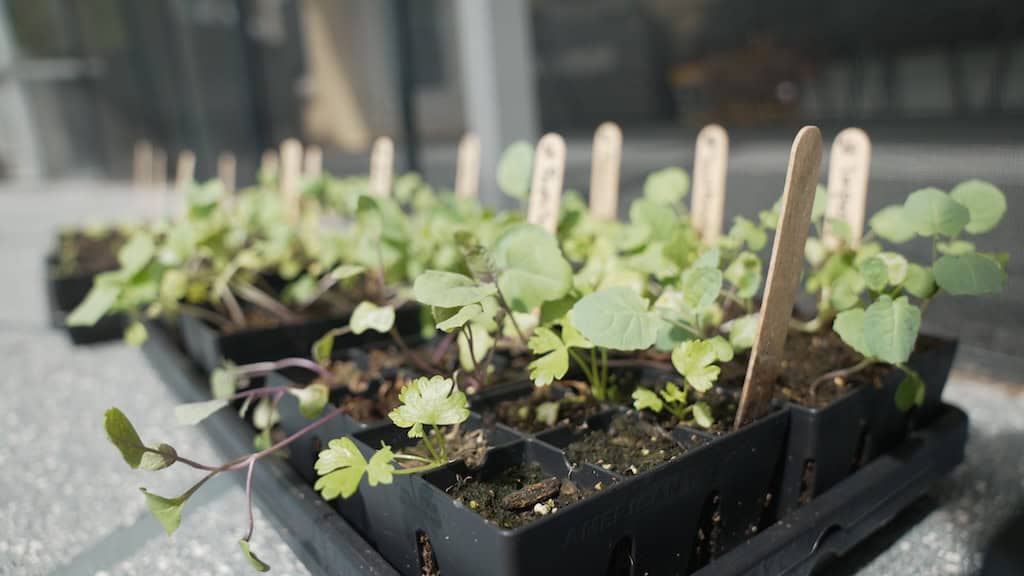Last Updated on October 3, 2024 by Homegrown Florida
This post may contain affiliate links. Read full disclosure here.
I’m excited to share with you five creative ways you can grow your own food, even if you’re working with a tiny space. Whether you’ve got an apartment, a small balcony, or you’re living that van life, you can still enjoy the satisfaction of growing your own fresh, delicious produce.
1. Grow Up, Not Out: Vertical Gardening

If you’re short on space, vertical gardening is your new best friend. Take a look at this obelisk —this is a perfect example of how you can grow up instead of out. Vertical structures like obelisks, tomato cages, and trellises allow you to maximize your space. You can plant something like a Corky stem passion vine (which is fantastic for pollinators) and still have room at the base for food-producing plants like ginger and turmeric. These plants don’t compete—they work together, utilizing the same pot but different resources.
You can also do this with tomato plants. Imagine a tomato plant climbing up the middle of your vertical structure, with green onions, basil, or radishes growing at the base. The tomato plant provides shade, and you get to grow more food in the same amount of space. It’s all about being smart with your space!
2. Stack Your Garden with Vertical Planters

Another great option to grow in small spaces is using vertical planters like Greenstalks. I’m a big fan of these because they’re super efficient—you can grow a ton of plants in a very small footprint. Each Greenstalk original vertical planter has five tiers, and each tier has six pockets for plants. That equals 30 plants in just 2 square feet. I use mine to grow herbs like parsley, basil, catnip, lemon balm, sage, oregano, and more. These planters are perfect for balconies where you might have limited light. They even come on wheels or spinner bases, so you can rotate them to ensure all your plants get the sun they need.
3. Get Creative with Hanging Baskets and Window Boxes

If you’re really tight on space, hanging baskets and window boxes are excellent options. You can grow strawberries in hanging baskets, or fill window boxes with herbs right in your kitchen. There are even ladder-style planters that fit neatly on a patio or balcony. And if you’re feeling adventurous, you can do something like I did—grow a big plant, like a Seminole pumpkin, up a palm tree. This way, you’re not taking up any ground space, and once the plant has finished its growing season, you can easily remove it without any long-term impact on the tree.
4. Join a Community Garden
If you’ve got absolutely no space at home, a community garden might be the perfect solution. These gardens are shared spaces where you can rent a plot to grow your own food. They’re often on donated land or public spaces, and they offer a great way to connect with other gardeners. Membership fees are typically reasonable and usually paid yearly. Some gardens also require volunteer hours, so you’ll want to ask about that during the introductory tour. Community gardens often offer classes and resources, making them an excellent option, especially if you’re new to gardening.
5. Go Indoors with Hydroponic Systems

If outdoor space is nonexistent, you can still grow food indoors with a hydroponic system like an AeroGarden. These systems are fantastic for growing small plants like tomatoes, peppers, lettuce, and herbs right on your countertop. The larger models can accommodate a surprising number of plants, while the smaller tabletop versions are perfect for starting seedlings or growing dwarf varieties. Just keep in mind that these systems are best for annuals vegetables and herbs. They can not support root crops like carrots or potatoes.
So there you have it—five ways to grow your own food, even in the smallest of spaces. Whether you’re growing up a trellis, stacking a vertical planter, getting creative with hanging baskets, joining a community garden, or setting up a hydroponic system indoors, there’s no reason you can’t enjoy fresh, homegrown produce.
Remember, you don’t need a lot of space to grow a lot of food. With a little creativity and planning, you can turn any small area into a productive garden. I hope you found these tips helpful—happy gardening!


